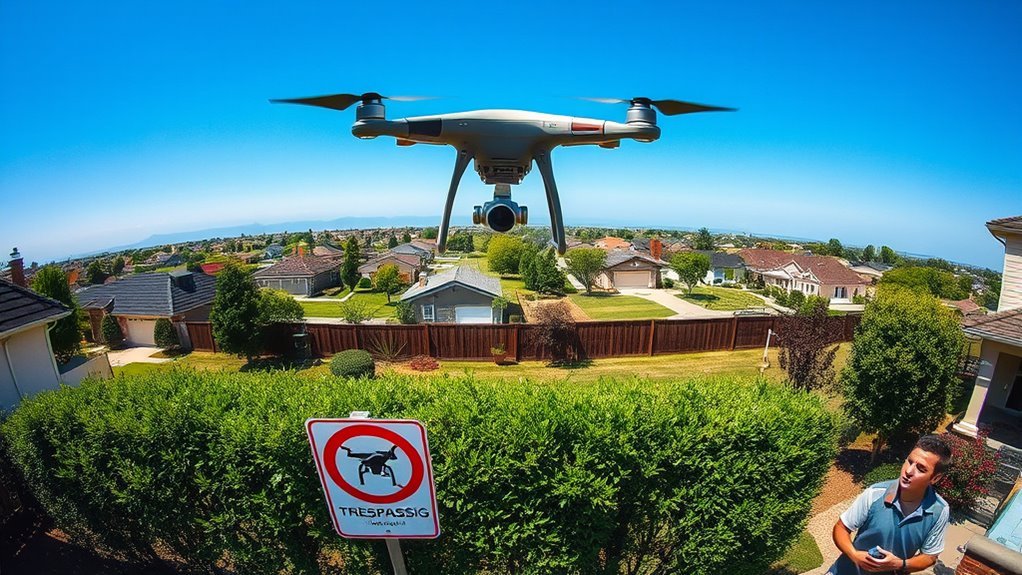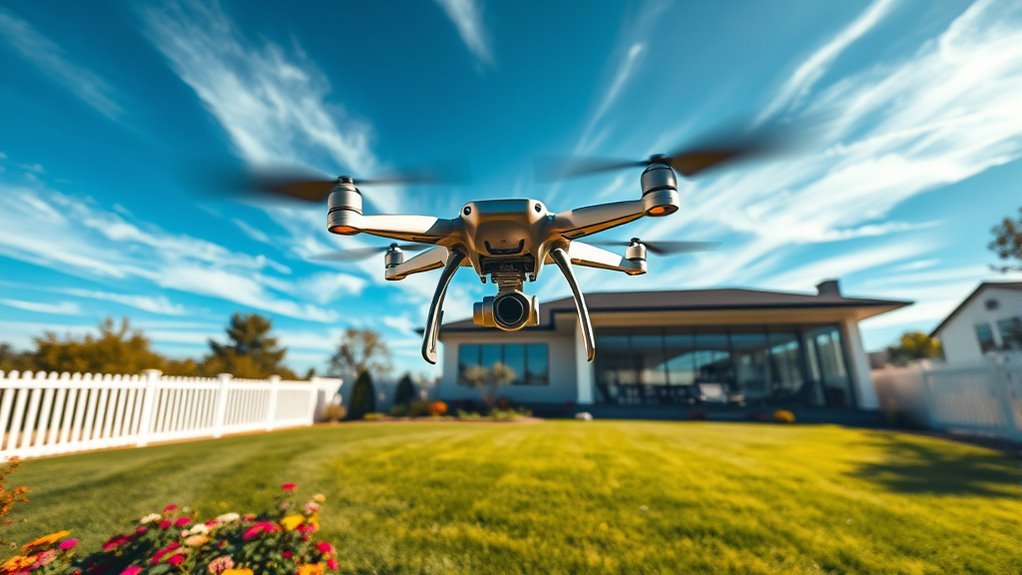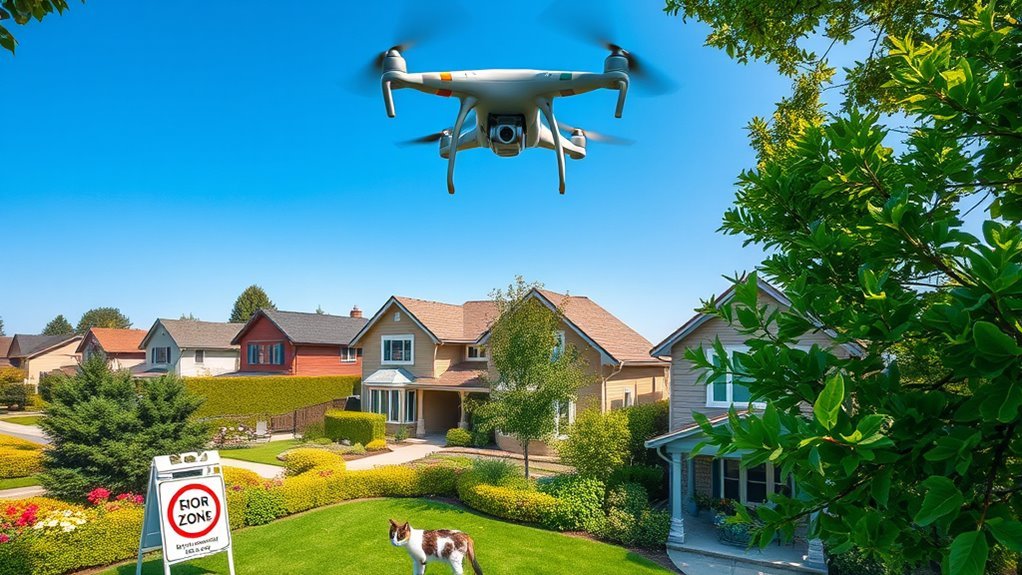To determine if it’s legal to fly drones over private property, you need to understand the intersection of federal, state, and local regulations. FAA rules dictate drone registration and airspace use. Additionally, property owners have rights that can lead to aerial trespass if drones fly too low. Privacy concerns can also arise, so it’s best to seek permission from property owners. Knowing these key points will guide you in responsible drone operation. More insights on this topic await.
Understanding Federal Drone Regulations

While maneuvering through the complex landscape of drone regulations, it is vital to understand the federal laws that govern their use. The Federal Aviation Administration (FAA) establishes these laws, ensuring safety and accountability in the national airspace. One significant aspect is drone registration; if your drone weighs over 0.55 pounds, you must register it with the FAA. This registration aids in federal enforcement, allowing authorities to track and address violations effectively. Understanding these regulations not only helps you fly legally but also enhances your freedom as a drone operator. Ignoring them can lead to fines or restrictions, so staying informed about your responsibilities is imperative. Embrace your freedom responsibly by maneuvering through the federal landscape with confidence.
State and Local Drone Laws

When operating drones, you need to be aware of state and local laws that may impose specific restrictions. Local ordinances can vary widely, affecting where and how you can fly your drone. Additionally, some states have enacted their own regulations that could further limit your aerial activities, so it’s essential to research these laws before taking off.
Local Ordinances and Regulations
As you navigate the intricacies of drone flight legality, understanding local ordinances and regulations is essential. Zoning laws can considerably impact your ability to fly drones, especially for aerial photography. Cities and counties often have specific rules governing airspace usage, which can limit where and when you can operate your drone.
Here are a few key considerations:
- Height Restrictions: Local laws may impose altitude limits for drone flights.
- No-Fly Zones: Certain areas, like schools or hospitals, may be off-limits for drone operations.
- Permits: Some municipalities require permits for commercial drone use, even for photography.
Familiarizing yourself with these ordinances can help you enjoy your drone flights while staying within legal boundaries.
State-Specific Restrictions
Understanding state-specific restrictions is essential for drone operators, since laws can vary greatly from one state to another. Each state has unique laws regarding drone use that dictate how close you can fly to property boundaries. Ignoring these laws could lead to legal repercussions and limit your freedom to operate.
| State | Restriction Type | Notes |
|---|---|---|
| California | No flying over private land | Respect property rights |
| Texas | Minimal restrictions | More freedom in rural areas |
| New York | Strict regulations | High density limits operations |
| Florida | Varies by county | Check local ordinances |
Always verify state laws before you fly to confirm you’re fully informed and can enjoy your aerial freedom without legal issues.
The Concept of Airspace and Property Rights

When considering drone flight legality, it’s critical to understand the definition of navigable airspace and how it intersects with property rights. Generally, property owners have rights extending only to a certain altitude, beyond which the airspace is considered public. This distinction can greatly impact your ability to operate drones over private land without infringing on property rights.
Navigable Airspace Definition
Although the concept of navigable airspace has evolved over time, it fundamentally represents the vertical space above private property where flight operations are permissible. Understanding navigable airspace types and airspace classification is essential for drone operators. Here are a few key points to take into account:
- Navigable airspace typically begins at 500 feet above ground level, allowing for safe flight without interfering with private property rights.
- Different airspace classifications, like Class G or Class B, dictate the rules for drone operation in specific areas.
- Recognizing where navigable airspace ends can help you avoid legal issues while enjoying your freedom to fly.
Property Rights Limitations
While property rights are often viewed as absolute, they are subject to limitations, especially in the context of airspace. You need to understand that your rights don’t extend infinitely above your property boundaries. The law typically recognizes a distinction between the ground and the airspace above it. This means that while you own the land, you may not necessarily own the airspace to a great height. Aerial trespass can occur when a drone violates the privacy or property rights of an individual by flying too low or without permission. Consequently, it’s vital to know where these legal boundaries lie to avoid conflicts and guarantee that your drone flights respect the rights of others while enjoying your freedoms.
Privacy Concerns and Legal Implications
How do drone flights impact privacy rights for property owners? The advent of drone surveillance has raised significant privacy concerns, with privacy laws struggling to keep pace. As you navigate these issues, consider the following:
- Expectation of Privacy: Property owners have the right to expect privacy within their own spaces. Moreover, drone operators must be aware of local regulations to prevent infringing on these rights.
- Legal Precedents: Courts are beginning to address how drone use intersects with existing privacy laws.
- Community Standards: Local norms can influence what’s deemed acceptable drone behavior.
Understanding these factors can help you assess the legality of drone flights over private property. If a drone crosses the line into intrusive surveillance, it may violate your privacy rights, leading to potential legal repercussions for the operator. Additionally, awareness of local drone regulations can empower property owners to take action against unauthorized surveillance. Stay informed and protect your freedoms.
Special Considerations for Commercial Drone Use
As commercial drone use becomes increasingly prevalent, understanding the specific legal frameworks governing these operations is vital for both operators and property owners. You’ll need to be aware that commercial drone pilots must obtain the appropriate certifications, such as a Part 107 license from the FAA. This guarantees that you’re not only qualified but also compliant with federal regulations. Additionally, securing commercial drone insurance is important, as it protects you from liability in case of accidents or damage to property. Many property owners might have concerns about drones flying over their land, so clear communication and respect for privacy laws can help mitigate conflicts. It is also essential to understand that registration and necessary permits are required before operating a drone in certain areas. By staying informed and prepared, you can operate within the legal boundaries while enjoying the freedom that commercial drone use offers. Furthermore, understanding state and local laws is crucial to ensure compliance with additional restrictions that may apply to your drone operations.
The Role of Homeowners Associations
Homeowners associations (HOAs) play an essential role in regulating drone use within their communities, influencing how residents can operate these devices over private property. It’s vital to understand your HOA’s homeowner regulations, as they often impose specific drone restrictions that can affect your flying experience.
Consider these points when reviewing your HOA’s rules:
- Privacy Concerns: Drones can capture images and videos, raising privacy issues among neighbors.
- Noise Levels: The sound of drones may disturb the peace, prompting restrictions.
- Safety Regulations: HOAs might require compliance with safety guidelines to prevent accidents. Additionally, Connecticut law emphasizes responsible drone use, ensuring operators are aware of privacy regulations and the need for consent before capturing images over private property.
Being aware of these factors will help you navigate the complexities of drone operation within your community while respecting both personal freedom and shared spaces.
Obtaining Permission From Property Owners
Understanding your HOA’s regulations is just one part of the equation when it comes to drone operation. Engaging with property owners directly is essential. Before flying, you should submit permission requests to guarantee respect for their privacy and property rights. This engagement fosters goodwill and may prevent future conflicts.
| Step | Action |
|---|---|
| Identify | Determine property owners |
| Communicate | Reach out respectfully |
| Request | Submit formal permission request |
| Follow-up | Confirm details and agreements |
| Respect | Adhere to agreed parameters |
Consequences of Illegal Drone Flights
Flying a drone over private property without permission can lead to serious consequences, both legally and socially. Understanding these repercussions is vital to maintaining your freedom while flying.
Flying a drone over private property without permission can lead to severe legal and social consequences. Always respect privacy to maintain your freedom.
- Legal Action: Property owners can file lawsuits against you for trespass, leading to potential fines and drone liability issues.
- Social Backlash: Neighbors may feel violated, resulting in strained relationships and negative community perception.
- Loss of Access: Unauthorized flights can lead to stricter regulations, limiting where you can legally operate your drone in the future.
In short, ignoring the need for permission can result in significant trespass repercussions that affect not just your drone use but also your standing within the community. Always prioritize respect for others’ privacy.
Frequently Asked Questions
Can I Fly My Drone Over My Neighbor’s House Without Permission?
You can’t fly your drone over your neighbor’s house without considering drone trespassing laws and neighbor consent requirements. It’s crucial to understand these regulations to avoid potential legal issues and respect their privacy.
Are There Specific Altitude Limits for Flying Drones Over Private Property?
When considering altitude limits, remember that maneuvering the skies requires understanding altitude regulations and airspace restrictions. Staying below 400 feet generally keeps you compliant, but always verify local laws to guarantee your freedom in flight.
How Do I Report Illegal Drone Flights Over My Property?
If you suspect illegal drone flights infringing on your property rights, report it to local authorities. Familiarize yourself with drone regulations, as they vary by location, ensuring you have the necessary information for effective reporting.
What Should I Do if a Drone Invades My Privacy?
If a drone invades your privacy, review local privacy laws and drone regulations. Document the incident, consider contacting authorities, and explore potential legal actions to protect your rights while advocating for personal freedom and privacy.
Can I Fly Drones for Recreational Use Over Private Land?
You can fly drones recreationally over private land, but you’ll need to be aware of drone regulations. It’s essential to respect others’ privacy and guarantee you’re not violating any local laws while enjoying your freedom.

